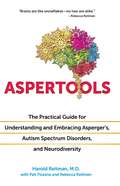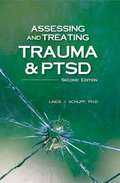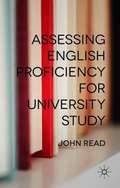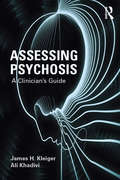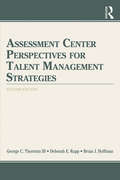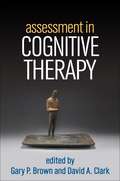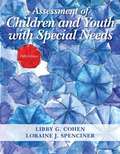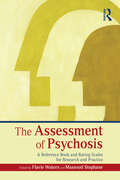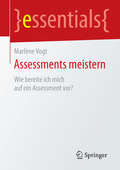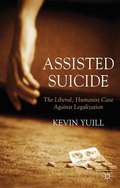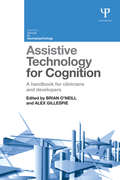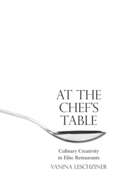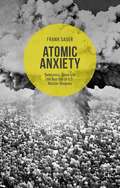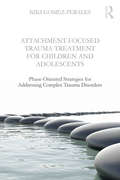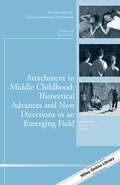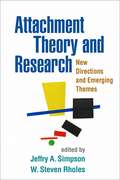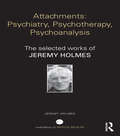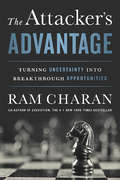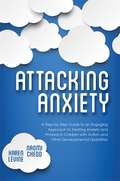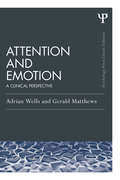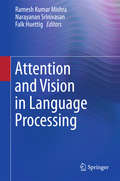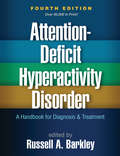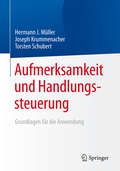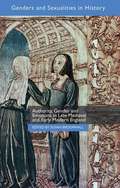- Table View
- List View
Aspertools: The Practical Guide for Understanding and Embracing Asperger's, Autism Spectrum Disorders, and Neurodiversity
by Dr. Harold ReitmanIf you ask Dr. Harold Reitman, labels are a lousy way to describe a unique human being, whether it's Asperger's, high functioning autism, ADHD, dyslexia, Tourette's or even the so-called neurotypical brain itself. One size does not fit all. Everyone's brain is different. Helping others 'get it' when it comes to dealing with those with so-called learning disabilities is why Reitman has written this book. It's also why he wrote and produced The Square Root of 2, a movie about a college student who encounters—and fights—her school's unjust system. The film was inspired by the real events faced by his daughter and contributing author, Rebecca, when she went to college; her seizure disorder and—at the time—undiagnosed Asperger syndrome posed unique challenges not faced by most students. After reviewing the scientific community's research, conducted over the last nearly 40 years, Dr. Reitman believes that it's time to not just accept neurodiversity, but to embrace it, and this book will help people do just that. It is the first book to offer simple tools, action plans and resources to help understand and deal with anyone whose brain is a bit different. The astonishing rate of autism births alone (1 in 68) means that society will have to adapt to neurodiversity, just as it has had to adapt to other cultural and racial differences. Our educational system, our workplaces, and society at large will no longer be one size fits all—each individual will have the opportunity to maximize their potential—and we will be the better for it.
Assessing and Treating Trauma and PTSD (Second Edition)
by Linda J. SchuppAssessing and Treating Trauma and PTSD, 2nd Edition, masterfully explores the nature of traumatic stress and provides spot-on assessment tools for various trauma-related criteria. The second edition updates include all trauma-related DSM-5 diagnoses, as well as new theories, research and therapeutic techniques. This collection of physiological and psychological techniques provides professions with a practical, eclectic approach to a variety of treatments. * "High-Risk" Indicators for PTSD * Changes from DSM-IV-TR to DSM-5 * DSM-5 Predictors for PTSD * Dissociation and Treatments * Attachment Theory and Neurobiology of Broken Attachment Bonds * Nutritional Supplement Update for the Prevention and Treatment of PTSD * Current Psychopharmacological Studies for PTSD * The Relationship as Therapy * Complex Posttraumatic Stress Disorder Criteria and Treatment
Assessing English Proficiency for University Study
by John ReadThis book focuses on strategies and procedures for assessing the academic language ability of students entering an English-medium university, so that those with significant needs can have access to opportunities to enhance their language skills.
Assessing Psychosis: A Clinician's Guide
by James H. Kleiger Ali KhadiviAssessing Psychosis: A Clinician’s Guide offers both a practical guide and rich clinical resource for a broad audience of mental-health practitioners seeking to sharpen their understanding of diagnostic issues, clinical concepts, and assessment methods that aid in detecting the presence of psychotic phenomena. Practicing psychiatrists, psychologists, social workers, and psychiatric nurses will find this a valuable resource for clinical practice, training, and teaching purposes.
Assessment Center Perspectives for Talent Management Strategies: 2nd Edition
by George C. Thornton III Deborah E. Rupp Brian J. HoffmanWritten by three leading scholars with vast experience in the science and practice of assessment centers (ACs), this is the first volume to comprehensively integrate variations of the assessment center method with alternative talent management strategies. A useful reference guide, it examines the many ways in which organizations can apply the assessment center method to achieve their talent management goals. It provides balanced and in-depth coverage of theory, research, and practice pertaining to the dimension-, task-, and multifaceted-perspectives on the AC method. Ideal for researchers, practitioners, and students alike, and well suited for courses in testing and measurement, personnel selection, HR planning and staffing, training and development, and organizational change, Assessment Center Perspectives for Talent Management Strategies is a complete and up-to-date account of the assessment center method.
Assessment in Cognitive Therapy
by Gary P. Brown David A. ClarkThis volume brings together leading experts to explore the state of the art of cognitive clinical assessment and identify cutting-edge approaches of interest to clinicians and researchers. The book highlights fundamental problems concerning the validity of assessments that are widely used in cognitive-behavioral therapy (CBT). Key directions for further research and development are identified. Updated cognitive assessment methods are described in detail, with particular attention to transdiagnostic treatment, evidence-based practice, cognitive case formulation, and imagery-based techniques.
Assessment of Children and Youth with Special Needs
by Libby G. Cohen Loraine J. SpencinerThis highly respected text focuses on current assessment issues and procedures that every special educator needs to know. The author's integrated approach emphasizes in-class assessment approaches as well as more formal measures and instruments. Throughout they provide numerous practical examples of how the techniques and procedures can be used in the classroom. Included are practical, ready-to-used materials integrated within instruction delivery methods; relevant case studies; and examinations of current assessment topics in every chapter.
The Assessment of Psychosis: A Reference Book and Rating Scales for Research and Practice
by Flavie Waters Massoud StephaneThis book reviews the descriptive features of psychotic symptoms in various medical conditions (psychiatric, early psychosis, general medical, neurological and dementia), non-medical settings (individuals without the need for care or at high risk for psychosis) and age groups (children and adolescents, adults, older adults). Similarly, the perspectives of many disciplines are provided (history, psychiatry, psychology, psychopathology, neurology, phenomenological philosophy) so that readers may become familiar with different approaches that are used to define, evaluate and categorize psychosis, at times independently of clinical diagnosis. This book is a resource book for those requiring an understanding of clinical and conceptual issues associated with psychosis, with chapters written by academics and clinicians who are leaders in their respective fields. The book also provides a guide regarding the methods of assessment for psychosis and its symptoms, with 120 rating scales, which are described and evaluated. The Assessment of Psychosis will be particularly useful to the clinical and research community, but also to readers interested in individual differences and human psychopathology.
Assessments meistern: Wie bereite ich mich auf ein Assessment vor? (essentials)
by Marlène VogtDieses Essential zeigt Ihnen, was Sie in einem Assessment erwartet und wie Sie sich darauf vorbereiten können. Zu diesem Zweck wird dargestellt, wie ein Assessment typischerweise aufgebaut ist, mit welchen Aufgaben und Übungen Sie konfrontiert sein werden und wie Sie diese am besten meistern können. Darüber hinaus erhalten Sie Anregungen, wie Sie mithilfe von klaren Zielformulierungen und einer ,,bewussten Haltung" während des Assessments Ihr Bestes geben und Ihre Kompetenzen unter Beweis stellen können.
Assisted Suicide The Liberal, Humanist Case against Legalization
by Kevin YuillThis book presents an atheistic case against the legalization of assisted suicide. Critical of both sides of the argument, it questions the assumptions behind the discussion. Yuill shows that our attitudes towards suicide - not euthanasia - are most important to our attitudes towards assisted suicide.
Assistive Technology for Cognition: A handbook for clinicians and developers (Current Issues in Neuropsychology)
by Brian O'Neill Alex GillespieAssistive technology for cognition is technology which can be used to enable, enhance, or extend cognitive function. This book systematically examines how cutting-edge digital technologies can assist the cognitive function of people with cognitive impairments, with the potential to revolutionize rehabilitation. Technologies are reviewed which direct attention, remind, recognize, prompt, and generally guide people through activities of daily living. Written by experts in neuropsychology and technology development, Assistive Technology for Cognition provides a comprehensive overview of the efficacy of technologies to assist people with brain impairments. Based on the list provided by the International Classification of Function, each chapter covers a different cognitive function; namely, attention, memory, affect, perception, executive function, language, numeracy, sequencing, and navigation onto which existing and future assistive technologies for cognition are mapped. This structure provides in-depth research in an accessible way, and will allow practitioners to move from an assessment of cognitive deficits to the prescription of an appropriate assistive technology for cognition. The chapters also make suggestions for future developments. Assistive Technology for Cognition will be of great interest to clinicians and researchers working in brain injury rehabilitation, technology developers, and also to students in clinical psychology, neuropsychology, and allied health disciplines.
At the Chef's Table: Culinary Creativity in Elite Restaurants
by Vanina LeschzinerThis book is about the creative work of chefs at top restaurants in New York and San Francisco. Based on interviews with chefs and observation in restaurant kitchens, the book explores the question of how and why chefs make choices about the dishes they put on their menus. It answers this question by examining a whole range of areas, including chefs' careers, restaurant ratings and reviews, social networks, how chefs think about food and go about creating new dishes, and how status influences their work and careers. Chefs at top restaurants face competing pressures to deliver complex and creative dishes, and navigate market forces to run a profitable business in an industry with exceptionally high costs and low profit margins. Creating a distinctive and original culinary style allows them to stand out in the market, but making the familiar food that many customers want ensures that they can stay in business. Chefs must make choices between these competing pressures. In explaining how they do so, this book uses the case study of high cuisine to analyze, more generally, how people in creative occupations navigate a context that is rife with uncertainty, high pressures, and contradicting forces.
Atomic Anxiety: Deterrence, Taboo And The Non-use Of U. S. Nuclear Weapons
by Frank SauerWith the concept of 'Atomic Anxiety', this book offers a novel perspective on one of the most important and longstanding puzzles of international politics: the non-use of U.S. nuclear weapons. By focusing on the fear surrounding nuclear weapons, it explains why nuclear deterrence and the nuclear taboo are working at cross purposes in practice.
Attachment-Focused Trauma Treatment for Children and Adolescents: Phase-Oriented Strategies for Addressing Complex Trauma Disorders
by Niki Gomez-PeralesAttachment-Focused Trauma Treatment for Children and Adolescents brings together two powerful treatment directions that exponentially expand the knowledge and skills available to child and adolescent trauma therapists. The book provides theoretical knowledge, clinical approaches, and specific, detailed techniques that clinicians will find indispensable in the treatment of the most challenging and high-risk young trauma victims. Also included are case studies, developed from over three decades of experience, that show the reader how to use the techniques in real-life settings. The treatment approach described here is flexible enough to adapt to real clients in the real world, regardless of trauma and attachment histories, family and living situations, or difficulties engaging in supportive therapeutic relationships. Clear and cohesive, the model presented here allows room for the individuality and approach of each therapist so that the therapeutic relationship can evolve in a genuine and unique way. An appendix of photocopiable worksheets gives interactive tools for therapists to immediately use with clients.
Attachment in Middle Childhood: New Directions for Child and Adolescent Development, Number 148 (J-B CAD Single Issue Child & Adolescent Development)
by Guy Bosmans Kathryn A. KernsOne of the critical factors in early development is the formation of a secure attachment, and it continues to be important for older children's responses to psychological stressors like hurt pride, fear, and sadness. This volume provides a timely review of research to date, describing important insights that have both theoretical and clinical importance as well as identifying remaining gaps in our understanding.Summarizing the most relevant findings, this volume is important for theory on child (attachment) development, and also for clinicians to broaden their understanding of the importance of middle childhood attachment processes for understanding the development of children’s behavior problems and for designing effective treatment strategies.This is the 148th volume in this Jossey-Bass series New Directions for Child and Adolescent Development. Its mission is to provide scientific and scholarly presentations on cutting edge issues and concepts in this subject area. Each volume focuses on a specific new direction or research topic and is edited by experts from that field.
Attachment Theory and Research
by Jeffry A. Simpson W. Steven RholesThis volume showcases the latest theoretical and empirical work from some of the top scholars in attachment. Extending classic themes and describing important new applications, the book examines several ways in which attachment processes help explain how people think, feel, and behave in different situations and at different stages in the life cycle. Topics include the effects of early experiences on adult relationships; new developments in neuroscience and genetics; attachment orientations and parenting; connections between attachment and psychopathology, as well as health outcomes; and the relationship of attachment theory and processes to clinical interventions.
Attachments: The selected works of Jeremy Holmes (World Library of Mental Health)
by Jeremy HolmesFor three decades Jeremy Holmes has been a leading figure in psychodynamic psychiatry in the UK and across the world. He has played a central role in promoting the ideas of John Bowlby and in developing the clinical applications – psychiatric and psychotherapeutic – of Attachment Theory in working with adults. Drawing on both psychoanalytic and attachment ideas, Holmes has been able to encompass a truly biopsychosocial perspective. As a psychotherapist Holmes brings together psychodynamic, systemic and cognitive models, alert to vital differences, but also keenly sensitive to overlaps and parallels. This volume of selected papers brings together the astonishing range of Holmes' interests and contributions. The various sections in the book cover: An extended interview – covering Holmes’ career and philosophy as a psychodynamic psychiatrist 'Juvenilia' – sibling relationships, the psychology of nuclear weapons, and the psychodynamics of surgical intervention. Psychodynamic psychiatry: Integrative and Attachment-Informed A psychotherapy section in which he develops his model of psychotherapeutic change 'Heroes' – biographical pieces about the major influences including, John Bowlby, Michael Balint, David Malan, Jonathan Pedder and Charles Rycroft. 'Ephemera' – brief pieces covering such topics as frequency of psychodynamic sessions and fees. Attachments: Psychiatry, Psychotherapy, Psychoanalysis - The Selected Works of Jeremy Holmes will be essential and illuminating reading for practitioners and students of psychiatry and psychotherapy in all its guises.
The Attacker's Advantage: Turning Uncertainty into Breakthrough Opportunities
by Ram CharanThe phenomenon of uncertainty is not new; what is new is its intensity and potential to change industries and destroy companies. Business leaders can be on the defensive, or they can be on offense, prepared to lead decisively. The ability to deal with uncertainty is perhaps the paramount skill leaders must have to be successful in this era. Without it they risk becoming personally obsolete and driving their companies off a cliff. In The Attacker's Advantage, renowned business expert and bestselling author Ram Charan shows what skills are needed to be able to spot the disruption that is coming, and what actions are necessary to take advantage of these changes. While many leaders know how to cope with operational uncertainty--when, for example, revenue fluctuates--the same cannot be said for dealing with structural uncertainty that can alter the money-making patterns of a company, industry or entire economic sector. Charan demonstrates the huge upside offered by structural uncertainty and provides the concepts and tools--such as being able to spot the catalysts of disruption, building organizational preparedness, developing a financial understanding of the consequences--to take advantage of forces that are creating new customer needs, market segments and ways to make money. Uncertainty is now ubiquitous. The sources of structural change are so varied and fast moving, and their convergence so unpredictable. Digitization and the integration of technologies through software and hardware has already impacted many businesses, but much more is to come. With his unparalleled ability to cut through complexity and provide workable solutions, Ram Charan provides his readers with the ability to anticipate and deal with the biggest threats facing their business.
Attacking Anxiety: A Step-by-Step Guide to an Engaging Approach to Treating Anxiety and Phobias in Children with Autism and Other Developmental Disabilities
by Karen Levine Naomi CheddDrawing on the principles of Cognitive Behavioral Therapy (CBT), this book sets out a clear, enjoyable, step-by-step approach for addressing the sorts of anxieties, fears and phobias that are so common in children and teens with Autism Spectrum Disorders (ASD) and related challenges. Using this easy-to-follow model, parents and professionals will have the tools they need to help children and teens cope with and sometimes overcome anxieties caused by everyday occurrences. The book covers seven common scenarios, from fears of environmental sounds and visiting the doctor or dentist, to anxieties around transitions, changes to schedules and an intolerance for making mistakes. The model can be adapted to suit almost any anxiety or phobia and is ideal for use at home, at school and in clinical settings where it can be integrated into a variety of treatment approaches and styles. Designed to help parents of children with autism spectrum disorders and the teachers and therapists who work with them, this book is an excellent resource for successfully alleviating many of the anxieties and phobias that interfere with life enjoyment, not only for the child but for the entire family.
Attention and Emotion: A clinical perspective (Psychology Press & Routledge Classic Editions)
by Adrian Wells Gerald MatthewsThis is a Classic Edition of Adrian Wells and Gerald Matthews’ award-winning textbook on attention and emotion, which now includes new section introductions. The book won the British Psychological Society book award in 1998, and is now widely seen as a classic in the field of emotional disorders. Attention and Emotion: A Clinical Perspective critically reviews the literature on attention and emotion, and offers an integrative cognitive attentional model of the development and maintenance of emotional disorders. The authors also discuss the implications for clinical practice of attentional theories of emotional dysfunction. In the new section introductions, the authors reflect on the influence of their ground-breaking model and the subsequent developments in the field, 20 years since the book was first published. The book will continue to be essential reading for students, researchers and professionals with an interest in disorders of attention and emotion.
Attention and Vision in Language Processing
by Ramesh Kumar Mishra Narayanan Srinivasan Falk HuettigThis volume provides a comprehensive overview of the nature of attentional and visual processes involved in language comprehension. Key concerns include how linguistic and non-linguistic processes jointly determine language comprehension and production and how the linguistic system interfaces with perceptual systems and attention. Language scientists have traditionally considered language in isolation from other cognitive and perceptual systems such as attention, vision and memory. In recent years, however, it has become increasingly clear that language comprehension must be studied within interaction contexts. The study of multimodal interactions and attentional processes during language processing has thus become an important theoretical focus that guides many research programs in psycholinguistics and related fields.
Attention-Deficit Hyperactivity Disorder, Fourth Edition: A Handbook for Diagnosis and Treatment
by Russell A. BarkleyWidely regarded as the standard clinical reference, this volume provides the best current knowledge about attention-deficit/hyperactivity disorder (ADHD) in children, adolescents, and adults. The field's leading authorities address all aspects of assessment, diagnosis, and treatment, including psychological therapies and pharmacotherapy. Core components of ADHD are elucidated. The volume explores the impact of the disorder across a wide range of functional domains--behavior, learning, psychological adjustment, school and vocational outcomes, and health. All chapters conclude with user-friendly Key Clinical Points. New to This Edition *Reflects significant advances in research and clinical practice. *Expanded with many new authors and new topics. *Chapters on cutting-edge interventions: social skills training, dietary management, executive function training, driving risk interventions, complementary/alternative medicine, and therapies for adults. *Chapters on the nature of the disorder: neuropsychological aspects, emotional dysregulation, peer relationships, child- and adult-specific domains of impairment, sluggish cognitive tempo, and more.
Attention-Deficit Hyperactivity Disorder in Adults and Children
by Lenard A. Adler Thomas J. Spencer Timothy E. Wilens Lenard A. Adler Thomas J. SpencerAttention-Deficit Hyperactivity Disorder (ADHD) is a chronic neurobehavioral disorder characterized by persistent and often acute distractibility, hyperactivity, and impulsivity. It is a condition usually associated with children but in recent years the diagnosis of ADHD in adults has risen significantly. ADHD often coexists with a wide array of other psychiatric illnesses, including depression and bipolar disorder, thus complicating its assessment and management. In Attention-Deficit Hyperactivity Disorder in Adults and Children, a team of world renowned experts bring together the recent research in this area and cover the history, diagnosis, epidemiology, comorbidity, neuroimaging, and a full spectrum of clinical options for the management of ADHD. The wide ranging, detailed coverage in this text will be of interest to psychiatrists, psychologists, social workers, coaches, physicians, or anyone who wants to develop a deeper understanding of the etiology, characteristics, developmental process, diagnostics, and range of treatment modalities.
Aufmerksamkeit und Handlungssteuerung: Grundlagen für die Anwendung
by Hermann J. Müller Joseph Krummenacher Torsten SchubertSelektive Aufmerksamkeit ist die Fähigkeit, relevante Informationen auszuwählen und nicht relevante oder störende zu ignorieren. Diese selektive Aufmerksamkeit spielt sowohl bei der Interaktionen mit anderen Menschen, der Bewegung in der Umwelt, der Nutzung von technischen Geräten, der Planung von zielgerichteten Handlungen wie auch bei der Kontrolle von Denkprozessen eine zentrale Rolle in der menschlichen Kognition. Ein wesentliches Merkmal dieses Buches liegt darin, dass verschiedene Phänomene der selektiven Aufmerksamkeit dargestellt werden und dass das in den einzelnen Kapiteln entwickelte Wissen auf Alltagssituationen im täglichen Leben bezogen werden kann. Auch kann es zur Lösung von Problemstellungen in diversen spezifischen Bereichen, z. B. im Bereich der Ergonomie angewandt werden. Zielgruppen für dieses Werk sind Studierende und praktisch Tätige in den Kognitionswissenschaften, Neurowissenschaften, Medizin, Mensch-Maschine-Schnittstelle, Software-Ergonomie, Sportwissenschaften, Ingenieurwissenschaften. Zum Inhalt: Basierend auf experimentellen Methoden werden die aus der aktuellen Forschung resultierenden Erklärungsansätze vorgestellt und diskutiert. Ein besonderes Augenmerk liegt dabei auf der Integration von kognitionspsychologischen Befunden und Modellen mit neurokognitiven Ansätzen. Dieser integrative Ansatz dient dazu, neurokortikale Korrelate von Aufmerksamkeitsphänomenen im Sinne der Aktivität spezifischer Gehirnmodule bzw. kortikaler Netzwerke zu beschreiben. Für das Verständnis des Buches unentbehrliche methodische Ansätze und theoretische Grundlagen werden im Haupttext gesondert in Textboxen herausgestellt. Für eilige Leser und für einen raschen und kurzen Überblick sind die wichtigsten Kernaussagen jeweils am Kapitelende zusammengefasst
Authority, Gender and Emotions in Late Medieval and Early Modern England
by Susan BroomhallThis collection explores how situations of authority, governance, and influence were practised through both gender ideologies and affective performances in medieval and early modern England. Authority is inherently relational it must be asserted over someone who allows or is forced to accept this dominance. The capacity to exercise authority is therefore a social and cultural act, one that is shaped by social identities such as gender and by social practices that include emotions. The contributions in this volume, exploring case studies of women and men's letter-writing, political and ecclesiastical governance, household rule, exercise of law and order, and creative agency, investigate how gender and emotions shaped the ways different individuals could assert or maintain authority, or indeed disrupt or provide alternatives to conventional practices of authority.
